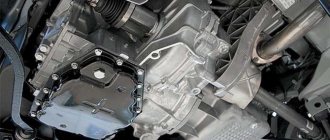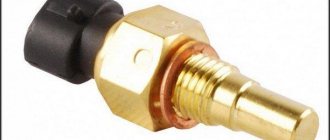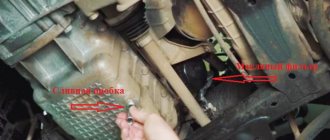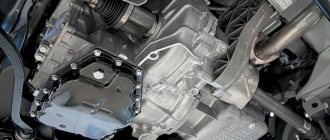August 20, 2015 Lada.Online 96 416 0
For Lada Largus, it is recommended to change the engine oil every 15,000 km. or after 1 year (whichever comes first). Under severe operating conditions (large city, very dusty area), replace the oil and filter every 7-8 thousand km.
| Engine model | Engine oil volume | Factory filled oil | Recommended oils |
| K7M (8 valve) | 3.3 liters | ELF SOLARIS RNX 5W-30 | Motor oils with quality class API SL / API SM / API SN / ACEA A1/ ACEA A2/ ACEA A3/ ACEA A5 and SAE viscosity level: 15W40; 15W50 10W40; 5W30; 5W40; 5W50; 0W30; 0W40 (depending on climatic conditions). |
| K4M (16 valve) | 4.8 liters |
When do you need to change the oil in a Lada Largus engine?
According to the replacement regulations from the manufacturer, it is necessary to change the oil in the Lada Largus engine every 15 thousand kilometers . However, taking into account the specifics of driving and operating conditions, this figure can be reduced to 10 thousand km.
To determine the need to change the oil, pay attention to signs of its depletion. The main indicator is the appearance: color change, the appearance of a burnt odor, impurities and sediment, and a decrease in lubricant thickness.
To detect these signs, regular preventative oil checks are necessary. During this procedure, the lubricant level is also measured using a dipstick. A situation in which the oil remains within the permissible range when heated and cooled is considered normal.
Despite the various processes that will begin with an excess or lack of lubrication in the system, the result will be the same - increased wear of engine components. Its consequence will be expensive repairs and replacement of entire units.
In this context, another set of signs are identified that indicate problems with the lubrication system. They are associated with engine malfunctions, jerking, and extraneous sounds.
Experts do not recommend waiting for such consequences to appear. Their presence indicates not only the need to change the engine oil, but also the demand for a full diagnosis of its components by specialists.
How to fill engine oil
We pour new oil into the engine through the oil filler neck, the amount of oil in the engine is indicated in the table above. (about 0.3 liters of oil will still remain in the engine). We control the level using the oil dipstick (the oil level should be between the MIN and MAX marks).
Start the engine and let it idle for a few minutes. The emergency oil pressure indicator should go out 2-3 seconds after starting the engine. While the engine is running, check for oil leaks from under the drain plug and oil filter. Stop the engine and check the oil level; if necessary, add oil to the specified level.
The entire process of changing the Lada Largus oil is also shown in the video:
Which oil should you choose?
The question of how to choose the right oil to replace in the engine is decided by the manufacturer’s recommendations for vehicle maintenance. For filling, the best option is the original lubricant - Elf SOLARIS RNX 5W-30. The following options are suitable alternatives:
- Shell 5W-40;
- Valvolin 5W-30;
- Gulf Formula G 5W-40;
- ZIC A+10W-40.
When choosing between mineral and synthetic oils, preference is given to the latter. Synthetics are more resistant to thermal and oxidative reactions, last longer and provide high-quality lubrication of working mechanisms.
Some car owners, however, prefer semi-synthetics for cars whose total mileage is more than 100 thousand km. This is due to the general wear and tear of parts and components, which can quickly become unusable due to synthetic lubricants.
Based on the viscosity of the oil, they are guided by seasonal temperature changes. The best options are 5W-30 and 5W-40, which are suitable for both frost and hot seasons.
Changing the engine oil
Experienced car owners know that recommendations regarding oil changes cannot be ignored. Ignoring this important process provokes incredibly complex breakdowns that impede not only a comfortable trip, but also completely make such movements impossible. Used oil fluid does not provide high-quality lubrication, so parts quickly fail due to excessive friction. We recommend that you allocate funds in time to purchase oil and pour it into the engine of your favorite car. We will tell you how to carry out such manipulations without making a single mistake, so you should not worry about your technical amateurism.
Replacement frequency
The incredible beauty “Lada Largus” is a joint “product” of AvtoVAZ and the Renault-Nissan concern. If you want your car to fly smoothly and beautifully along the highways, then we recommend listening to the manufacturers' recommendations. Who better to know the needs of their “child” than the parent-producer.
Preparing for work
Preparing to change the oil in the Lada Largus engine involves purchasing parts and components. You will also need to choose a convenient place where you will work on the car.
When purchasing, pay attention to the quality of consumables. Along with the lubricating fluid, be sure to change the filter and drain plug gasket. If necessary, other components whose wear has reached or will soon reach a critical state must also be replaced.
You should buy new parts only from trusted suppliers and official dealers. When purchasing, pay attention to compliance with the article numbers, as well as the presence of a license and quality certificates.
After acquiring all the consumables, they proceed to preparing the work site. If possible, use a viewing hole, overpass or lift. It is also permissible to use a jack and supports to evenly lift the vehicle.
The need to observe safety precautions during work is especially emphasized. For better drainage, the engine is warmed up, however, given the heating and toxicity of the oil, there is a danger of thermal and chemical burns.
In this context, the use of protective clothing and rubber gloves is relevant. In the case of self-replacement, any things that you don’t mind getting dirty will do. You will also need a container to drain the used lubricant - it is not allowed to get into the soil.
Taking into account the recommendations presented, the necessary tools and equipment for changing the oil are included in the following list:
- overalls, lint-free rags or rags, gloves;
- set of socket wrenches, square 8;
- container for draining used lubricant with a volume of 5 liters;
- new oil, filter, rubber seals and gaskets, other parts as needed.
The final stage of preparation is warming up the engine. After this step, proceed directly to the oil change procedure.
Process of draining waste
Before you begin, you need to prepare the necessary materials yourself. Namely:
- Transmission fluid;
- Oil filter;
- The key is set to “10” and the tetrahedron is set to “8”;
- Clean rags;
- Container for draining waste with a capacity of at least 5 liters;
- A brush, preferably a metal one.
Oil change tools
The work is performed on a warm engine. After a short trip, you need to drive the car onto an overpass. First, unscrew the filler cap. Then use a wire brush to clean the drain plug. It is located on the underside of the engine crankcase. When unscrewing the cap, you must be especially careful so as not to get burned. Drain the waste into the prepared container. This will take 10-15 minutes. Degrease the plug and screw it back on.
Removing Engine Oil
Another important point: the steel washer located under the plug requires replacement if the rubber gasket is damaged.
Do-it-yourself oil change in the Lada Largus engine
Step-by-step instructions for changing the oil in the Lada Largus engine include the following steps:
- after the engine warms up, uncork the filler neck to speed up draining;
- in the lower part, remove the engine protection, if any, and place a container to collect the lubricant;
- uncork the drain while the oil drains - clean the plug and change the gasket;
- unscrew the filter, change the cartridge and rubber seals;
- clean and wipe the seat dry, reinstall the filter element;
- after draining the oil, clean the drain hole and tighten the plug;
- New lubricant is poured into the system, the engine is warmed up for 10-15 minutes;
- check the lubricant level and tightness of connections for leaks.
The filter can be replaced before unscrewing the drain hole - the procedure in this matter is not critical. However, to save time, the process is carried out simultaneously with draining the used lubricant.
When it comes to filling volume, they focus on a value of 5 liters. The exact value is determined in accordance with the engine size and the manufacturer's recommendations. Some people focus on the amount of liquid drained.
The best option is to fill up to 70% of the required volume and then top up with measurements of the current level. This option allows you to avoid excess or lack of oil, but you also need to take into account possible changes after the first warm-up of the engine.
The cooling system elements are checked for preventive purposes. The procedure is optional, and taking into account the frequency of replacing antifreeze, it seems to many to be completely unnecessary. However, it allows you to detect and eliminate faults in a timely manner, ensuring high-quality and reliable engine operation.
During preventive maintenance, attention is paid to the main connections of the cooling system, checked for tightness, leaks and serviceability of fasteners. The condition of the antifreeze itself is also assessed; a significant change in color and the appearance of sediment indicates the need for replacement.
Features of changing oil in 8-valve and 16-valve engines
Changing the oil in a Largus 16 valve engine is carried out according to the same scheme as in cars with 8 valves. This is due not only to the relatedness of the assemblies, but also to the standardization of the overall process.
Engine features do not affect the choice of oil; certain differences will only be in the volume of lubricant poured. 16 valves require about 5 liters, while changing the oil in a Largus 8 valve engine requires 4 liters.
There are also nuances with the location of the filter. It is easy to recognize by its cylindrical blue casing, but access to it may be limited.
In both cases, unscrewing is done by hand. If it doesn’t work, use a special tool. However, when tightening, you should not use the same tools - tighten the casing by hand, otherwise it may burst.
All steps for changing oil on Largus “step by step”
Let's consider what to do before changing the oil in the Lada Largus engine if the number of valves is 16:
- Warm up the engine, turn off the ignition, drive the car into the pit;
- Remove the crankcase protection.
You need a 10mm socket wrench - use it to unscrew the six screws from the bottom; Fastening the crankcase protection - Immediately unscrew the filler cap (yellow plastic).
The protection is removed for one purpose - to get to the filter.
Draining waste (old engine oil)
There is no crankcase protection now. All that remains is to take the 8-sided socket and unscrew the drain plug.
Drain hole for plug
Make 1-2 turns with the key, then place an empty container and unscrew the cap by hand.
The time for draining used oil is at least 10 minutes. Be careful, the oil is hot!
After the waste has drained, the surface of the crankcase is wiped and the plug is wrapped. Thread tightening torque – 22 N*m.
Replacing the oil filter
It would seem that the old material has been drained and now is the time to complete the replacement. But you still need to change the oil filter.
Filter housing - put a puller on it
It is easier to access the filter housing from below. We take the puller and unscrew the filter by rotating the housing counterclockwise.
100-200 ml of waste will flow out of the old filter.
The new filter housing must be filled with oil, but not completely, but by a third. You will need 70-100 ml of material. The rubber seal is lubricated with the same oil.
Preparing the filter for installation
After wiping the engine crankcase, screw in the new filter until it stops. The tightening torque will be 15-17 N*m (by hand).
Pour in new oil
The oil volume in the Lada Largus engine, if the timing belt contains 16 valves, is 5 liters. You need to fill 4.8 liters through the neck. Then close the plug and start the engine.
The indicator light is now on
The point is to turn off the oil pressure light. We start, wait three minutes and turn off the engine.
Even if the control lamp did not light up, wait 5-6 minutes and check the level. The check is carried out using a dipstick, and you can find it near the power steering reservoir.
Oil level dipstick
We remove the dipstick and look at the marks. If necessary, add oil. The main thing is to return the dipstick to its place, pressing it all the way.
The filler neck can also be used to pump out oil. Thin tubes and a bulb will help solve the problem.
Oil change intervals
The frequency of oil changes in the Lada Largus engine is 15 thousand km. However, when making calculations, individual factors that influence the production of lubricating fluid should be taken into account:
- duration of trips around the city, frequency of stops and turns;
- aggressive driving style, high speeds;
- environment, annual and daily temperature changes;
- dustiness of roads, their surface, slipping.
All this can reduce the service life of the lubricant to 10 thousand km. In this context, regular oil checking becomes recommended. Its implementation will allow us to determine the frequency of lubricant replacement at an individual level.
The consequences of untimely oil changes are related to its functionality. In addition to lubricating mechanisms, this liquid provides heat and work product removal. Increased engine overheating will be the first consequence of its expired service life.
When heated, the working parts will begin to wear out faster, which will increase sediment and impurities in the circulating fluid. This will lead to clogging of the filter and reduce its throughput, which will cause oil starvation in the main engine components.
Further consequences depend on the total mileage of the vehicle and the service life of its components. The older the parts, the faster they will begin to fail and the larger the subsequent repairs will be.











